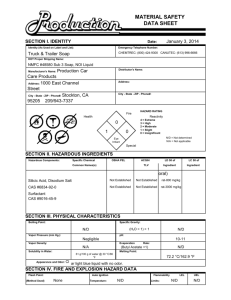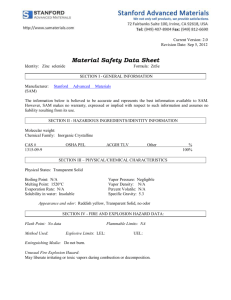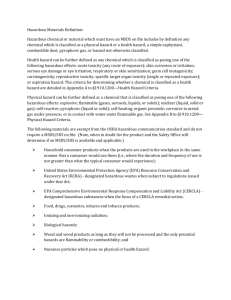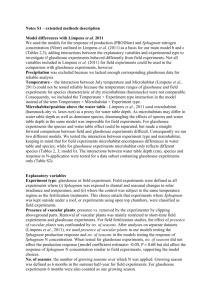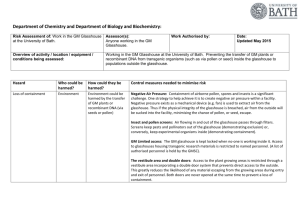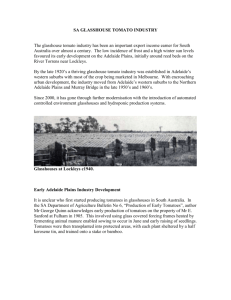Glasshouse use
advertisement
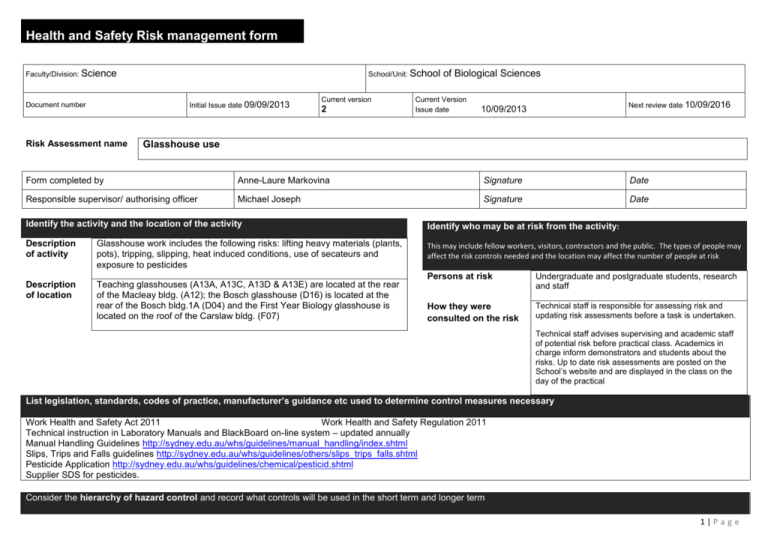
Health and Safety Risk management form Faculty/Division: Science School/Unit: School Initial Issue date 09/09/2013 Document number Risk Assessment name Current version 2 of Biological Sciences Current Version Issue date Next review date 10/09/2016 10/09/2013 Glasshouse use Form completed by Anne-Laure Markovina Signature Date Responsible supervisor/ authorising officer Michael Joseph Signature Date Identify the activity and the location of the activity Identify who may be at risk from the activity: Description of activity Glasshouse work includes the following risks: lifting heavy materials (plants, pots), tripping, slipping, heat induced conditions, use of secateurs and exposure to pesticides This may include fellow workers, visitors, contractors and the public. The types of people may affect the risk controls needed and the location may affect the number of people at risk Description of location Teaching glasshouses (A13A, A13C, A13D & A13E) are located at the rear of the Macleay bldg. (A12); the Bosch glasshouse (D16) is located at the rear of the Bosch bldg.1A (D04) and the First Year Biology glasshouse is located on the roof of the Carslaw bldg. (F07) Persons at risk Undergraduate and postgraduate students, research and staff How they were consulted on the risk Technical staff is responsible for assessing risk and updating risk assessments before a task is undertaken. Technical staff advises supervising and academic staff of potential risk before practical class. Academics in charge inform demonstrators and students about the risks. Up to date risk assessments are posted on the School’s website and are displayed in the class on the day of the practical List legislation, standards, codes of practice, manufacturer’s guidance etc used to determine control measures necessary Work Health and Safety Act 2011 Work Health and Safety Regulation 2011 Technical instruction in Laboratory Manuals and BlackBoard on-line system – updated annually Manual Handling Guidelines http://sydney.edu.au/whs/guidelines/manual_handling/index.shtml Slips, Trips and Falls guidelines http://sydney.edu.au/whs/guidelines/others/slips_trips_falls.shtml Pesticide Application http://sydney.edu.au/whs/guidelines/chemical/pesticid.shtml Supplier SDS for pesticides. Consider the hierarchy of hazard control and record what controls will be used in the short term and longer term 1|P a g e Elimination Not possible Eliminate the hazard or task if the risk outweighs the potential benefits. Substitution Not possible Substitute the hazard with something less hazardous e.g. less toxic substance. Isolation Possible Isolate the hazard by using barriers or distance. Engineering Possible Look for physical design solutions, controls, safety lockouts or automation to reduce or eliminate risks. Minimise Possible Minimise the size or volume of the hazard or time of exposure to the hazard. Rearrange Workflow Possible Rearrange activities to minimise lifting/handling/overuse injuries Administrative Possible Establish Safe Work Practices e.g. restrict access, have Safe Work Practice documentation and procedures for hazardous tasks. Training and Supervision Possible Provide training and supervision appropriate to level of expertise of the person(s) involved. Record training in SWP. Personal Protective Equipment Possible Use only as a secondary measure to supplement other risk controls e.g. gloves, lab coats, safety glasses. Identify hazards and control the risks. 1. An activity may be divided into tasks. For each task identify the hazards and associated risks. Also list the possible scenarios which could sooner or later cause harm. 2. Determine controls necessary based on legislation, codes of practice, Australian standards, manufacturer’s instructions etc. 3. List existing risk controls and any additional controls that need to be implemented Task or Hazard Associated harm Existing risk controls Scenario Current risk Any additional controls required? Residual risk Bend your knees to lift large plants Hold loads close to the body. Store loads close to where they will be used and try to store heavy items near waist height. Carrying plants/pots to glasshouse Lifting heavy weights Sprain & strain Trolleys are used to transport heavy materials to and from the glasshouses Medium to high Don’t lift, push or pull anything too heavy – break the load down into smaller lots. Medium Use mechanical aids such as a trolley or get help when lifting heavy loads. Don’t lift heavy items while you're sitting down Watering Tripping over hose and slipping on wet floor Working in glasshouse for extended periods Heat induced conditions Cuts & abrasions Staff wear non slip shoes and put hose away after use Medium Glasshouse floors are professionally cleaned once or twice a year or as required. Low Heatstroke and heat exhaustion Take regular breaks, let other staff members that you are working in the glasshouse Medium Avoid dehydration by regularly moving out of glasshouse and drinking water Low 2|P a g e Task or Hazard Associated harm Existing risk controls Scenario Pruning plants Using secateurs Spraying plants with pesticides (white oil) considered nonhazardous substance Exposure to non-hazardous chemicals by inhalation or skin adsorption Spraying plants with pesticides considered hazardous substance Exposure to hazardous chemicals Cuts to fingers Staff wear thick gloves appropriate to the task at hand. Sharper plant material may require leather gloves. Not known so prevention of exposure is the aim Various Current risk Any additional controls required? Residual risk Low None Low Read material data sheet for pesticides being used. Follow SWP for the pesticides being used. Staff wear appropriate PPE: Rubber gloves, long sleeves & long pants, gumboots, goggles, PVC apron, type A – class 1 respirator Low The pest controller is to prominently display a notice at all entrances to the treatment area i.e. "Warning: pesticides being applied in this area". Low Elimination High Hazardous pesticide spraying not allowed without a separate risk assessment, training etc. Low 3|P a g e 4|P a g e List emergency procedures and controls List emergency controls for how to deal with fires, spills or exposure to hazardous substances and/or emergency shutdown procedures Sprains & strains Rest patient and injured part Apply ICEPACK (cold compress) wrapped in a wet cloth to the injury for 15 minutes every 2 hours for 24 hours, then for 15 minutes every 4 hours for 24 hours Apply COMPRESSION elastic bandage firmly to extend well beyond the injury Elevate injured part Cuts & abrasions Control bleeding Clean wound and apply dressing Seek medical aid if necessary Heat exhaustion Lie patient down in cool area Loosen tight clothing Sponge with cool water Give water to drink if conscious If patient vomits, seek medical aid Heatstroke Apply cold packs to groin, armpits & neck Cover patient with wet sheet Ensure an ambulance has been called (dial 000) Give water to drink if conscious If patient has a seizure or becomes unconscious, seek medical aid Chemical poisoning If patient is unconscious: Ensure an ambulance has been called (dial 000) If patient is conscious: Give patient reassurance Determine type of poison taken Call 13 11 26 for Poison Information Centre Send vomit sample (if available) to hospital http://www.stjohn.org.au/images/stjohn/information/fact_sheets/FS_sprains.pdf http://www.stjohn.org.au/images/stjohn/information/fact_sheets/FS_bleeding.pdf http://www.stjohn.org.au/images/stjohn/information/fact_sheets/FS_heat.pdf http://www.stjohn.org.au/images/stjohn/information/fact_sheets/FS_poison.pdf Work Health and Safety Act 2011 Work Health and Safety Regulation 2011 Laboratory Safety Guidelines http://sydney.edu.au/whs/guidelines/others/laboratory_safety.shtml Technical instruction in Laboratory Manuals and BlackBoard on-line system – updated annually Implementation Additional control measures needed: None Resources required Responsible person Date of implementation 5|P a g e REVIEW Scheduled review date: Are all control measures in place? 12 months 2 years 3 years Are controls eliminating or minimising the risk? Are there any new problems with the risk? Review by: (name) Review date: Acknowledgement of Understanding All persons performing these tasks must sign that they have read and understood the risk management. Note: for activities which are low risk or include a large group of people (e.g. open days, BBQ’s, student classes etc), only the persons undertaking the key activities need to sign below. For all others involved in such activities, the information can be covered by other methods including for example a safety briefing, induction, and/or safety information sheet (ensure the method of communicating this information is specified here) Risk management name and version number: Name V2 I have read and understand this risk management form Signature Date 6|P a g e


